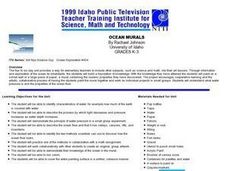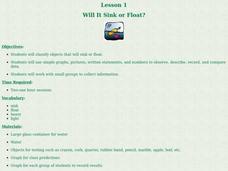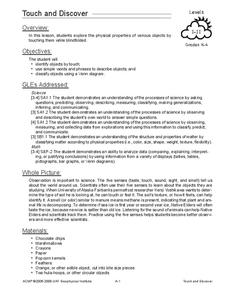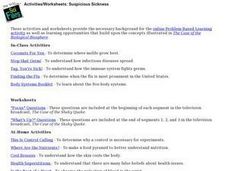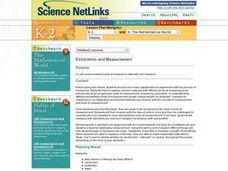Curated OER
Ocean Murals
Students identify characteristics of water. They describe the process by which light decreases and pressure increases as water depth increases. They demonstrate the principle of water pressure in a small group experiment.
Curated OER
Flight Dreams - Flight Factors
Students investigate the physics of flight by experimenting in class. In this history of flight lesson, students define terms such as gravity, lift, and drag in order to better understand how a plane is able to stay in the air....
Curated OER
Veggie Chop and Data Analysis
First graders chop vegetables into fractions. In this fractions lesson plan, 1st graders cut vegetables, collect data about favorite vegetables and create a bar graph using the information. Students make inferences about the data...
Curated OER
Exploring the Moon
First graders complete an experiment illustrating why the moon appears to change over time using a flashlight and ball. Students discuss the shape of the moon and identify it as a sphere. Students write a short informational piece after...
Curated OER
Will It Sink or Float?
Students perform experiments to see if items will sink or float. In this sink or float lesson, students work in groups to make predictions, and record the results. After the experiments are complete students make a book of the results.
Curated OER
What is a Seed?
First graders identify the parts of a seed. In this plant biology lesson, 1st graders are given a seed and identify each part of the seed by using a hand lens. Students plant a seed and graph the growth.
Curated OER
The Human Memory
This is a well-designed, creative lesson to help students learn more about the human memory. Working in pairs, students complete tasks and gather data. Excellent websites for resources are also provided.
Curated OER
Making It Balance
Students listen to story, "The 100-Pound Problem," compare their weight with character in story, and weigh different classroom items using nonstandard units and standard units. They experiment with different items that can make scale...
Curated OER
Starfish: The Stars of the Sea Lesson Plan
Students discover many characteristics of the starfish. In this early childhood lesson plan, students identify characteristics of starfish. Students develop a language experience chart and record their new-found information, and...
Curated OER
Fun With Adhesives
Students observe, measure, and record the properties in making objects stick together using science tools. In this science lesson plan, students explore with their senses while mixing flour and water. Additionally, students share their...
Curated OER
Counting Chart
Elementary learners discover counting through a counting chart. In this math lesson, students identify numbers 1-100. They then point or recite their counting numbers.
Curated OER
Touch and Discover
Young scholars identify the physical properties of items using the sense of touch. In this touch and discover lesson, students describe items. Young scholars sort items using a Venn diagram.
Curated OER
Learning about Infectious Diseases
All of the activities and worksheets in this unit relate to learning about how infectious diseases spread & how the body deals with them. There is a collection of problem-based learning activities, as well very useful at-home...
Curated OER
Extendable Bonko
Students create musical instruments to see how the length effects the pitch. For this Bonko activity, students use various size tubes to create a Bonko. Students experiment to observe the difference in the pitch.
Curated OER
Race the Track! Design Challenge
Students use the design process to investigate physical science. For this force and motion lesson, design a track to achieve a specified outcome. Students complete additional experiments with speed and distance. Students...
Curated OER
Why is it so hot when I sit next to the window?
Students investigate how energy travels through glass. In this energy usage lesson, students conduct an experiment in which they decide if window film affects how much energy travels through the glass. Students use a journal to make...
Curated OER
Sorting
Students experience sorting. In this organization lesson, students play a computer sorting game called "Flood Game" on the "Between the Lions" website. Students visit a library and observe and discuss book organization. Students work in...
Curated OER
Estimation and Measurement
Students explore measurement and estimation with non-standard units. In this measurement lesson, students discuss items that could be used to measure; they use tooth picks to measure specific items around the classroom, both estimating...
Curated OER
Ice Cream Toppings
Students explore the five senses. In this senses lesson plan, students use their senses to top their ice cream. Students compare and contrast the different toppings and write their observations, using descriptive words, in a notebook.
Curated OER
Mighty Oaks from Little Acorns
What does it mean to grow? To germinate? For the plan detailed here, class members investigate the growth process of an oak tree while focusing on the beginning stages of planting and germination. They plant seeds and record observations...
Curated OER
The Mitten
Explore the Ukraine through a reading of The Mitten. Readers will determine the sequence of events, cause and effect, make predictions, and find the main idea of the story. They also use math skills to make charts and graphs. Finally,...
Santa Clara County Office of Education
The Rainbow Fish: Activities for Parents to Do with Children at Home
The Rainbow Fish, Marcus Pfister's award-winning story about the joys of sharing, is the inspiration for this resource loaded with fun. Suggestions for language and language arts, math, science, and social studies activities are...
Curated OER
Potential Energy: How is It Related to Kinetic Energy?
Students explore kinetic and potential energy. In this energy lesson, students launch toys cars from ramps in order to examine the relationship between potential energy and kinetic energy. Students collect data and graph the results.
Curated OER
Numbers as Descriptors
Students use numbers as descriptors. In this mathematical inquiry lesson, students use numbers to describe, classify, and compare plants. Students are made aware that numbers can be used to describe things in the world around them.
